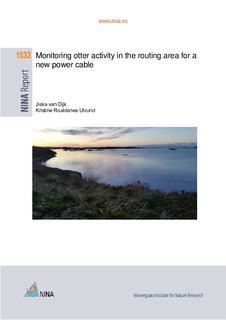Monitoring otter activity in the routing area for a new power cable
Research report

Åpne
Permanent lenke
http://hdl.handle.net/11250/2504541Utgivelsesdato
2018Metadata
Vis full innførselSamlinger
- NINA Rapport/NINA Report [2341]
Sammendrag
Van Dijk, J. & Ulvund, K. R. 2018. Monitoring otter activity in the routing area for a new power cable. NINA Report 1533. Norwegian Institute for Nature Research.
The island Aukra, also known as Gossa, located in Aukra municipality, Møre og Romsdal County, is known for its industrial area at Nyhamna, which is operated by Shell Norge AS. The Aukra island holds portions of very good quality otter habitat and long-term monitoring of otters reveals that the otters use especially the coastal areas outside the industrial plant. The monitoring project started in 2008 with the first monitoring of otter activity and sampling of otter spraint (faeces) for DNA-analysis. The last four years, otter spraint have been sampled during early spring and late autumn, depending on the weather conditions, in order to analyse the local otter density estimation.
Plans for a new power cable has prompted the need for a more detailed otter study in the area that will be affected by building activities around this new power cable. NINA has been asked to examine the otter activity in the possible routing area for the new power cable. In the area around the potential routing for the new power cable, three individual otters have successfully been identified from the DNA analyses in 2015 and 2016. In samples collected in 2015 (February and October) and in 2016 (March and November) three individuals have been identified in at least three out of the four sampling rounds (Ulvund et al. 2016). In samples collected between November 2017 and February 2018 two individuals have been identified of which one was also identified between 2015-2016 and one was a new individual. This indicates that several individuals are resident in the area and are likely territorial individuals, but that it also varies over time with that new otter individuals come in and known individuals disappear (i.e. move to another area or die). Since otters can breed and rear young throughout the year, it is not possible to give advice on a certain time of year that will provide the least disturbance for the otters. We therefore suggest that the potential routing for the cable is based on the botanical findings and mapping of cultural heritage sites. When Shell has made the decision on the approximate route of the new power cable, we can map the otter den sites and day resting sites in this particular area precisely and study their use before the building activities starts, during the building activity and their use after the activity is finished (year 2021-2022).